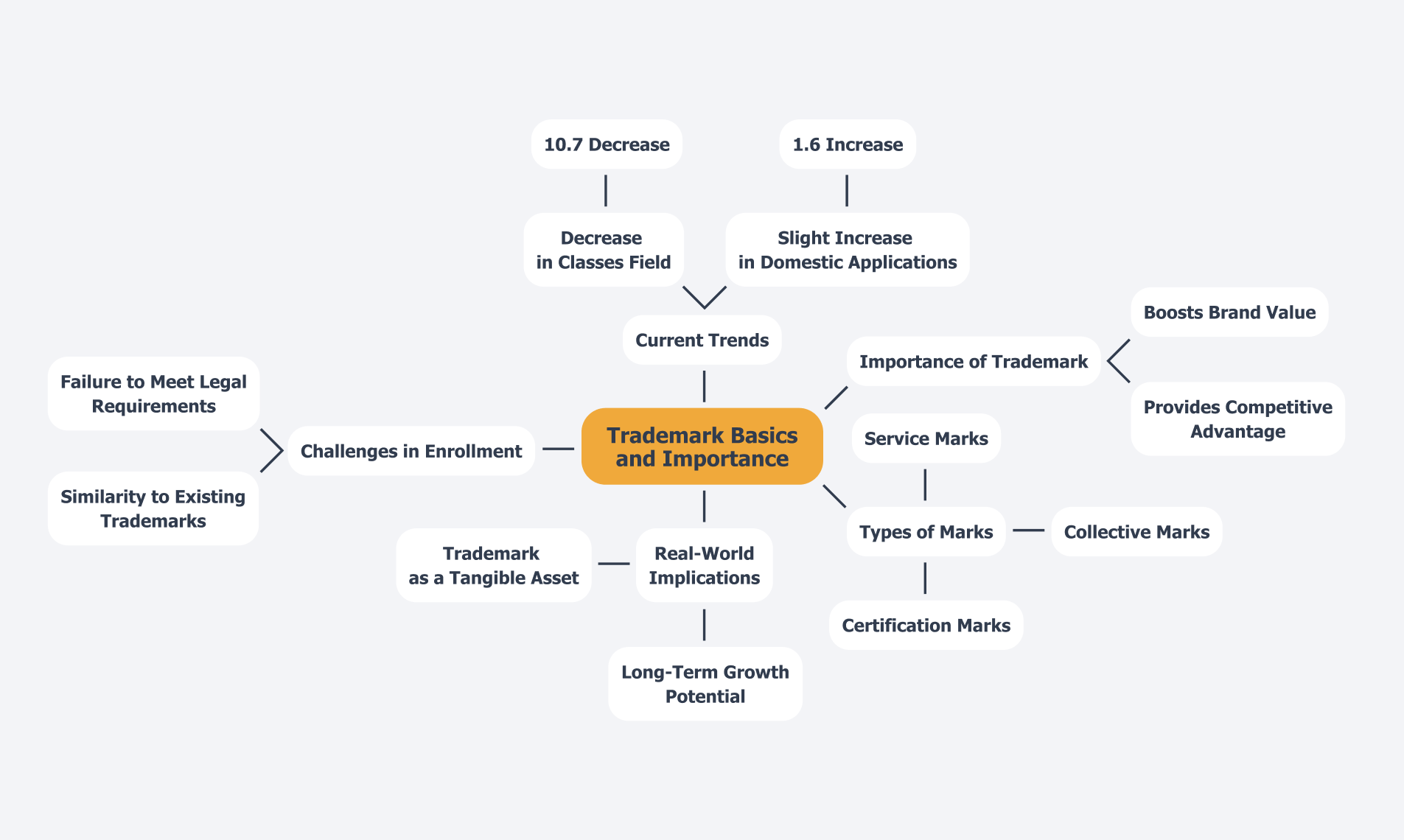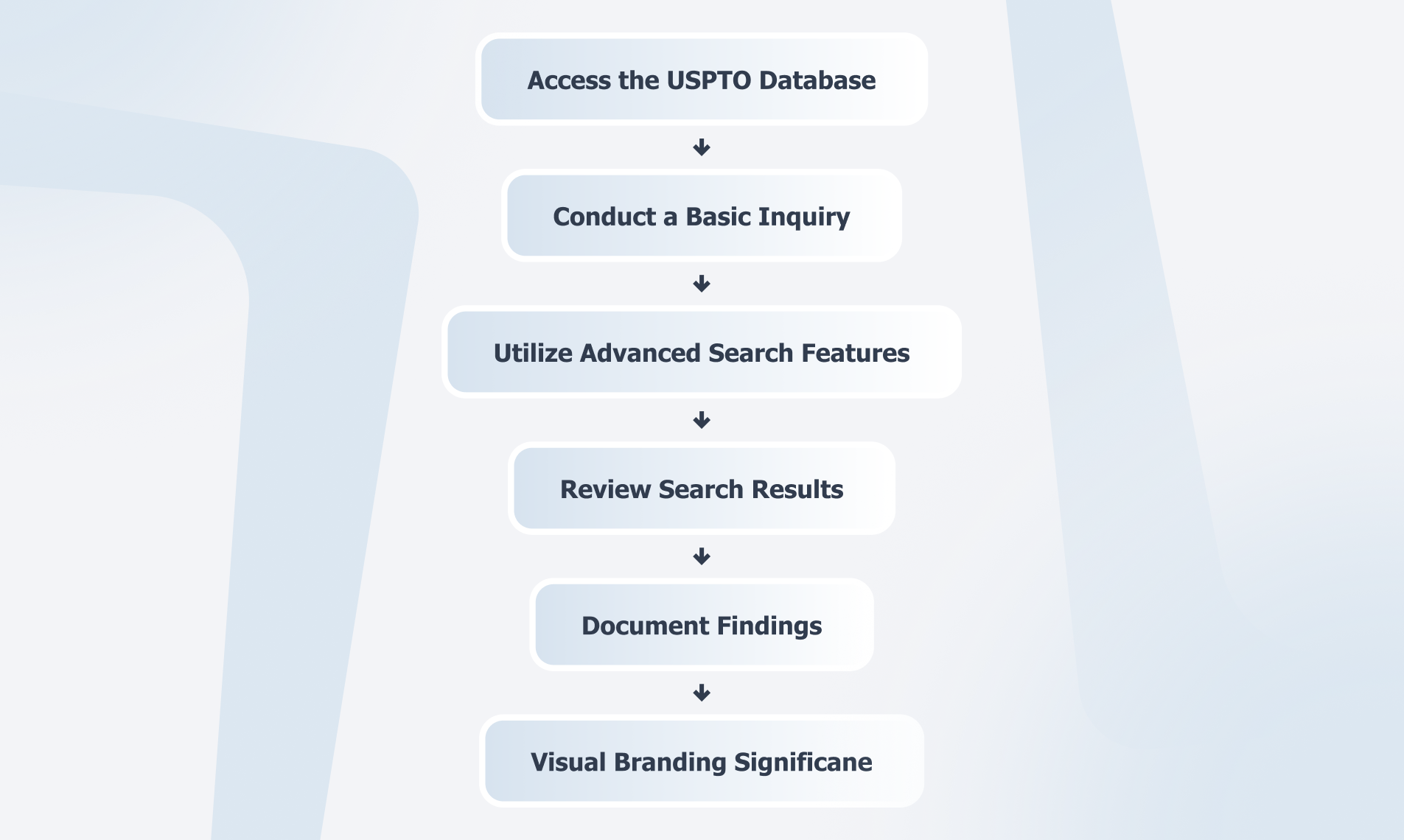Overview
The effective online search trademark process is crucial for anyone looking to protect their brand identity. Understanding trademark basics is the first step, followed by systematic search procedures that ensure thorough investigation and planning.
Utilizing the USPTO database for searches is essential; it provides the necessary resources to navigate potential challenges. Addressing these challenges proactively can significantly enhance the chances of successful trademark registration.
By following these steps, individuals can safeguard their intellectual property and reinforce their brand’s presence in the market.
Introduction
In the competitive landscape of business, trademarks are invaluable assets that define and protect brand identity. As companies strive to carve out their niche, understanding the nuances of trademark registration becomes increasingly critical. With various types of trademarks in play and the growing significance of intellectual property, businesses must effectively navigate the complexities of trademark searches and registrations.
This article delves into the essentials of trademark basics, outlines step-by-step procedures for conducting thorough searches, and highlights common pitfalls to avoid. By arming entrepreneurs with this knowledge, we aim to secure their brand’s future in an ever-evolving marketplace.
Understand Trademark Basics and Importance
A brand is a distinctive sign, design, or expression that identifies the source of products or services. Understanding brand identifiers requires knowledge of their various categories, including service marks, collective marks, and certification marks. These marks serve multiple purposes: they safeguard identity, prevent consumer confusion, and confer legal rights against infringement.
In 2025, the importance of securing a brand mark cannot be overstated; it not only boosts brand value but also provides a vital competitive advantage in the marketplace. Statistics reveal that over 50% of companies assign greater value to their IP ownership, underscoring the significance of brand identifiers in driving business growth. Notably, the number of classes filed in applications has decreased by 10.7%, reflecting trends that corporate IP managers should consider.
Challenges may arise during the enrollment process, such as resemblance to existing brands or failure to meet legal criteria, which highlights the necessity for comprehensive investigation and planning, including an online search trademark. Real-world examples demonstrate that trademark registration is a crucial investment for companies aiming to strengthen their identity in global markets.
By securing exclusive rights to distinctive elements, companies position themselves for long-term success and recognition, ensuring stability and growth across global markets. The case study titled ‘Conclusion on Trademark Registration’ illustrates that by establishing exclusive rights to their unique brand elements, businesses enhance their brand value and protect their identity, which is essential for navigating the complexities of international markets.
Familiarizing oneself with these concepts is vital for conducting an effective online search trademark inquiry, as it influences evaluation criteria and highlights the importance of distinctiveness in branding.

Follow Step-by-Step Procedures for Online Trademark Searches
- Access the USPTO Database: Start by visiting the United States Patent and Trademark Office (USPTO) website and navigating to the Trademark Electronic Search System (TESS), the primary database for federal trademarks.
- Conduct a Basic Inquiry: Use the basic inquiry feature to input your proposed trademark. Begin with the exact name, then expand your search to include variations or similar names to capture a broader range of results.
- Utilize Advanced Search Features: If your initial search yields inconclusive results, transition to the advanced search options. Here, you can refine your results by filtering categories such as goods and services, brand status, and registration type.
- Review Search Results: Analyze the results carefully. Conduct an online search trademark to identify brands that are identical or similar to your proposed mark, paying close attention to the associated goods or services to assess potential conflicts. Notably, Class 9 (technology) was the most sought-after category for applications in 2023, accounting for 20% of total submissions, which may be relevant based on your sector.
- Document Findings: Maintain a comprehensive log of your findings, including brand names, filing numbers, and their statuses. This documentation is crucial for future reference and legal matters.
In 2023, 80% of registration requests included logos or design elements, underscoring the significance of visual branding in establishing identity recognition and customer loyalty. This substantial percentage indicates that effective visual branding is vital for brand awareness and customer loyalty, influencing your outcomes and success in registration. Additionally, with 10% of brand applications being for international filings via the Madrid Protocol, understanding the intricacies of brand inquiries is essential for global business strategies. As Nyall Engfield noted, Tencent has emerged as the most active filer of marks in recent years, highlighting the competitive landscape of mark filings. By adhering to these steps, you can enhance your trademark investigation process and significantly improve your chances of successful registration.

Troubleshoot Common Issues in Trademark Searches
- Query Limitations: When encountering restrictions in results, confirm that you are using the appropriate parameters. Double-check spelling and consider utilizing synonyms or related terms to broaden your range of inquiry. In 2022, 18% of application submissions focused on environmental sustainability, underscoring the significance of precise terminology in niche markets. Additionally, iPNOTE provides guidance on Freedom To Operate (FTO) patent challenges, which can be essential when conducting an online search trademark in specialized fields.
- Confusing Similarities: Encountering brands that are similar yet not identical necessitates a careful assessment of the likelihood of confusion. Factors such as the nature of the goods or services and the target market play a crucial role. According to expert insights, a significant percentage of brand applications face confusion issues, highlighting the need for thorough analysis. As US Patent Attorney Vic Lin states, “Given that the chances of success at the appeal stage are so slim, your first argument may practically end up being your last argument.” Consulting with a legal expert in intellectual property can provide clarity in ambiguous situations related to an online search trademark.
- Technical Issues: If you experience technical difficulties with the USPTO website, consider clearing your browser cache or switching to a different browser. Accessing the site during off-peak hours can also alleviate server overload. The USPTO’s Trademark Trial and Appeal Board Reading Room offers valuable resources that can assist in navigating these challenges.
- Incomplete Queries: If your results seem partial, it’s crucial to verify state brand databases and global registries. Numerous companies operate under state certifications that might not be evident in federal inquiries, potentially leading to oversight.
- Legal Advice: For complex issues or potential conflicts related to online search trademark, seeking legal advice from an IP attorney is advisable. They can provide tailored guidance to navigate the complexities of intellectual property law, ensuring that your inquiry and registration process is as efficient as possible. The USPTO’s Trademark Pilot Program for Expedited Examination illustrates how collaborative efforts can enhance communication and reduce processing times, ultimately improving the quality of brand applications. This program can be particularly beneficial for those troubleshooting trademark search issues.
Conclusion
Understanding the intricacies of trademark registration is essential for any business aiming to establish a strong brand identity. This exploration into the fundamental aspects of trademarks emphasizes their critical role in protecting brands and preventing consumer confusion.
By recognizing the various types of trademarks and the significance of registering them, businesses can enhance their market presence and safeguard their intellectual property.
The step-by-step procedures for conducting trademark searches highlight the importance of thorough research in avoiding potential conflicts during registration. This process not only aids in identifying similar trademarks but also equips businesses with the necessary tools to navigate the complexities of trademark law. As demonstrated, meticulous preparation and documentation are vital components of a successful trademark strategy.
Moreover, addressing common issues that arise during trademark searches reinforces the need for diligence and professional guidance. Are you aware of the potential pitfalls? By seeking legal advice when necessary, businesses can significantly improve their chances of successful trademark registration. Ultimately, investing time and resources into understanding trademarks will not only protect a brand’s identity but also contribute to its long-term growth and recognition in an increasingly competitive marketplace.
Protect Your Brand with Effortless Trademark Registration! Start now with iPNOTE and navigate the complexities of IP management with ease.
Frequently Asked Questions
What is a brand?
A brand is a distinctive sign, design, or expression that identifies the source of products or services.
What are the different categories of brand identifiers?
The different categories of brand identifiers include service marks, collective marks, and certification marks.
What purposes do brand marks serve?
Brand marks safeguard identity, prevent consumer confusion, and confer legal rights against infringement.
Why is securing a brand mark important in 2025?
Securing a brand mark is important because it boosts brand value and provides a vital competitive advantage in the marketplace.
What does the statistic about companies valuing their IP ownership indicate?
Over 50% of companies assign greater value to their intellectual property (IP) ownership, highlighting the significance of brand identifiers in driving business growth.
What trend has been observed regarding the number of trademark application classes filed?
The number of classes filed in applications has decreased by 10.7%, which is a trend that corporate IP managers should consider.
What challenges may arise during the trademark enrollment process?
Challenges may include resemblance to existing brands or failure to meet legal criteria, emphasizing the need for comprehensive investigation and planning.
Why is trademark registration considered a crucial investment for companies?
Trademark registration is crucial as it strengthens a company’s identity in global markets and secures exclusive rights to distinctive elements, which is essential for long-term success and recognition.
How does the case study titled ‘Conclusion on Trademark Registration’ illustrate the benefits of trademark registration?
The case study demonstrates that establishing exclusive rights to unique brand elements enhances brand value and protects identity, which is essential for navigating international markets.
Why is it important to familiarize oneself with brand identifiers for conducting an online search trademark inquiry?
Familiarizing oneself with brand identifiers is vital as it influences evaluation criteria and highlights the importance of distinctiveness in branding.






